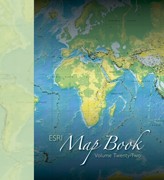RTI International - News Release - 7.23.2007
RTI Maps Featured in New Book on Geographic Information System Cartography

RESEARCH TRIANGLE PARK -- Maps developed by an RTI International researcher that depict daily commuting patterns in the United States were chosen for inclusion in ESRI Map Book, Volume Twenty-Two, a new book featuring the year's best examples of geographic information system cartography released by the Environmental Systems Research Institute, Inc.
The maps were developed as part of the Models of Infectious Disease Agent Study, an initiative sponsored by the National Institute of General Medical Sciences, a division of the National Institutes of Health.
The goal of the initiative is to provide policy makers, public health officials and others within the scientific community with the analytical tools and computer models required to respond effectively to infectious disease outbreaks, whether they occur naturally or are released intentionally in a bioterrorist attack.
The maps show changes in the number of inbound versus outbound commuters across the country visualized as elevations. The maps include state boundaries, urban areas, interstates and major highways.
"By understanding the movement patterns of people, we get a better idea of where people come from and who they interact with at work and then how they spread out to go home," said David Chrest, a geographic information system, or GIS, specialist at RTI International who created the maps. "Knowing those patterns can help researchers and government officials better predict the spread of infectious disease and prepare for potential outbreaks."
The three maps, based on data from the 2000 U.S. Census, show where people are going, where they are coming from, and the areas that are gaining people versus those that are losing people during daily commutes. The maps also include insets of some of the heaviest commuting areas such as Los Angeles, Denver, Chicago and New York.
RTI's GIS program brings together the combined expertise of geographers, IT experts, scientists, engineers, statisticians and economists to develop state-of-the-art maps that illustrate complex phenomena and geographical relationships among social and health policy data, environmental data, and economic data. These maps transform data into information tools that policy makers can use to better understand and improve the human condition.
ESRI Map Book, Volume Twenty-Two demonstrates how GIS is being applied to a variety of fields including government, natural resources, transportation and health. The book is available on the ESRI Web site as well as leading commercial bookseller Web sites.
